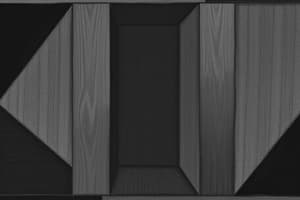Podcast
Questions and Answers
Opposite sides of a parallelogram are always congruent.
Opposite sides of a parallelogram are always congruent.
True (A)
The diagonals of a parallelogram always bisect each other.
The diagonals of a parallelogram always bisect each other.
True (A)
Diagonals of a parallelogram are always congruent.
Diagonals of a parallelogram are always congruent.
False (B)
If one pair of opposite sides of a quadrilateral are parallel and congruent, then it is an isosceles trapezoid.
If one pair of opposite sides of a quadrilateral are parallel and congruent, then it is an isosceles trapezoid.
Consecutive sides of a parallelogram are congruent.
Consecutive sides of a parallelogram are congruent.
A square is the only parallelogram whose diagonals are congruent.
A square is the only parallelogram whose diagonals are congruent.
The consecutive angles of a parallelogram are congruent.
The consecutive angles of a parallelogram are congruent.
A trapezoid is a parallelogram.
A trapezoid is a parallelogram.
The diagonals of a rhombus are perpendicular to each other.
The diagonals of a rhombus are perpendicular to each other.
A rectangle is a square.
A rectangle is a square.
A square is a rectangle.
A square is a rectangle.
The diagonals of a rectangle are congruent.
The diagonals of a rectangle are congruent.
If the diagonals of a quadrilateral are perpendicular to each other, then the quadrilateral is a rhombus.
If the diagonals of a quadrilateral are perpendicular to each other, then the quadrilateral is a rhombus.
A parallelogram is a rhombus.
A parallelogram is a rhombus.
Each diagonal of a rectangle bisects two angles of the rectangle.
Each diagonal of a rectangle bisects two angles of the rectangle.
A square is a rhombus.
A square is a rhombus.
Some squares are rectangles (but not all).
Some squares are rectangles (but not all).
Opposite sides of a parallelogram are congruent.
Opposite sides of a parallelogram are congruent.
A rectangle is equiangular.
A rectangle is equiangular.
The diagonals of a rhombus are perpendicular bisectors of each other.
The diagonals of a rhombus are perpendicular bisectors of each other.
A square is both a rectangle and a rhombus.
A square is both a rectangle and a rhombus.
If the diagonals of a quadrilateral bisect each other, then the quadrilateral is a rectangle.
If the diagonals of a quadrilateral bisect each other, then the quadrilateral is a rectangle.
If the diagonals of a parallelogram are perpendicular to each other then the quadrilateral is a rhombus.
If the diagonals of a parallelogram are perpendicular to each other then the quadrilateral is a rhombus.
In a quadrilateral, if one pair of opposite sides are congruent and parallel, then it is a parallelogram.
In a quadrilateral, if one pair of opposite sides are congruent and parallel, then it is a parallelogram.
If the diagonals of a quadrilateral are congruent then it is a rectangle.
If the diagonals of a quadrilateral are congruent then it is a rectangle.
Base angles of an isosceles trapezoid are congruent.
Base angles of an isosceles trapezoid are congruent.
Diagonals of an isosceles trapezoid bisect each other.
Diagonals of an isosceles trapezoid bisect each other.
Opposite angles of an isosceles trapezoid are supplementary.
Opposite angles of an isosceles trapezoid are supplementary.
If two sides of a trapezoid are congruent, then it is an isosceles trapezoid.
If two sides of a trapezoid are congruent, then it is an isosceles trapezoid.
A diagonal of a parallelogram divides it into two congruent triangles.
A diagonal of a parallelogram divides it into two congruent triangles.
Diagonals of a kite are perpendicular to each other.
Diagonals of a kite are perpendicular to each other.
If the diagonals of a quadrilateral are perpendicular and congruent, then the quadrilateral is a rectangle.
If the diagonals of a quadrilateral are perpendicular and congruent, then the quadrilateral is a rectangle.
If the diagonals of a parallelogram are perpendicular and congruent, then it is a rectangle.
If the diagonals of a parallelogram are perpendicular and congruent, then it is a rectangle.
If the diagonals of a quadrilateral are congruent, perpendicular, and bisect each other, then it is a rectangle.
If the diagonals of a quadrilateral are congruent, perpendicular, and bisect each other, then it is a rectangle.
The diagonals of a trapezoid are congruent.
The diagonals of a trapezoid are congruent.
Flashcards are hidden until you start studying
Study Notes
Parallelogram Properties
- Opposite sides of a parallelogram are always congruent.
- Diagonals of a parallelogram always bisect each other.
- Diagonals are not always congruent; this property is true only for rectangles and squares, but not for rhombuses.
- Consecutive sides of a parallelogram are congruent only in rhombuses and squares.
Quadrilaterals and Trapezoids
- If one pair of opposite sides of a quadrilateral is parallel and congruent, it does not necessarily indicate an isosceles trapezoid.
- A trapezoid is not considered a parallelogram; it is simply a quadrilateral.
- Each diagonal of a trapezoid does not bisect the other unless it's an isosceles trapezoid.
Special Quadrilaterals
- Diagonals of a rhombus are always perpendicular to each other, forming right angles.
- All squares are rectangles, but not all rectangles are squares.
- The diagonals of a rectangle are always congruent.
Conditions for Specific Quadrilaterals
- A quadrilateral with perpendicular diagonals could be a rhombus or a square, but not exclusively defined as one.
- A parallelogram is not necessarily a rhombus; it can also be a rectangle.
- If the diagonals of a quadrilateral are congruent, it is not always a rectangle; it could be an isosceles trapezoid.
Isosceles Trapezoid Characteristics
- Base angles of an isosceles trapezoid are congruent.
- Opposite angles of an isosceles trapezoid are supplementary.
- If two sides of a trapezoid are congruent, it does not confirm it as an isosceles trapezoid without knowing which sides.
Triangle Properties in Parallelograms
- A diagonal of a parallelogram divides it into two congruent triangles.
Kite Properties
- Diagonals of a kite are perpendicular to each other.
Conditions for Rectangles
- If a quadrilateral has diagonals that are congruent, perpendicular, and bisect each other, it is classified as a rectangle.
Studying That Suits You
Use AI to generate personalized quizzes and flashcards to suit your learning preferences.




